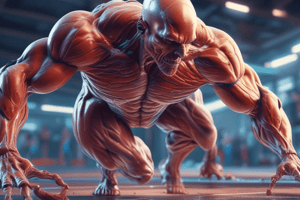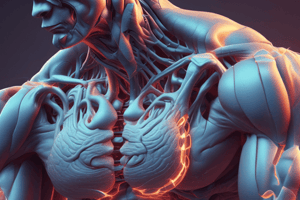Podcast
Questions and Answers
What branch of physics studies the behavior of physical bodies under forces and displacements?
What branch of physics studies the behavior of physical bodies under forces and displacements?
- Optics
- Mechanics (correct)
- Thermodynamics
- Kinematics
In which plane do flexion and extension occur for the thumb?
In which plane do flexion and extension occur for the thumb?
- Oblique plane
- Frontal plane (correct)
- Sagittal plane
- Transverse plane
What are the two primary types of motion for the body and its segments?
What are the two primary types of motion for the body and its segments?
- Translatory and rotary (correct)
- Static and dynamic
- Cyclic and random
- Linear and angular
What is meant by degrees of freedom in relation to joint movement?
What is meant by degrees of freedom in relation to joint movement?
Which movement occurs in the sagittal plane rather than the frontal plane?
Which movement occurs in the sagittal plane rather than the frontal plane?
What type of axis does forearm rotation utilize when it is no longer considered longitudinal?
What type of axis does forearm rotation utilize when it is no longer considered longitudinal?
How many degrees of freedom are typically found in joints of the human body?
How many degrees of freedom are typically found in joints of the human body?
The term 'planes of motion' is used to describe what aspect of movement?
The term 'planes of motion' is used to describe what aspect of movement?
What happens to a muscle's force development as the speed of concentric contraction slows?
What happens to a muscle's force development as the speed of concentric contraction slows?
What characterizes a maximum isometric contraction?
What characterizes a maximum isometric contraction?
What leads to a decreased ability of a muscle to produce contraction force as shortening speed increases?
What leads to a decreased ability of a muscle to produce contraction force as shortening speed increases?
How does the moment arm of a muscle impact joint rotation?
How does the moment arm of a muscle impact joint rotation?
What occurs during eccentric contraction in relation to muscle strength?
What occurs during eccentric contraction in relation to muscle strength?
At what speed do the maximum number of crossbridges form?
At what speed do the maximum number of crossbridges form?
What happens to the number of links formed between actin and myosin filaments as the contraction speed increases?
What happens to the number of links formed between actin and myosin filaments as the contraction speed increases?
What is the relationship between speed of contraction and the ability to develop force in concentric vs eccentric contractions?
What is the relationship between speed of contraction and the ability to develop force in concentric vs eccentric contractions?
What type of joint is characterized by a spherical head fitting into a cup-like depression?
What type of joint is characterized by a spherical head fitting into a cup-like depression?
Which of the following types of joints allows for no movement?
Which of the following types of joints allows for no movement?
Which movement involves the circular or conical motion of a body part?
Which movement involves the circular or conical motion of a body part?
What is the main difference between circumduction and rotation in joint movement?
What is the main difference between circumduction and rotation in joint movement?
Which joint type includes examples like sutures and gomphoses?
Which joint type includes examples like sutures and gomphoses?
What role does the glenoid cavity of the scapula play in the shoulder joint?
What role does the glenoid cavity of the scapula play in the shoulder joint?
What is the main anatomical feature of ball-and-socket joints?
What is the main anatomical feature of ball-and-socket joints?
Which movement refers to turning or spinning around a central axis?
Which movement refers to turning or spinning around a central axis?
What occurs when a motor unit’s nerve activates its muscle fibers?
What occurs when a motor unit’s nerve activates its muscle fibers?
Which principle describes the order of motor unit activation during muscle contraction?
Which principle describes the order of motor unit activation during muscle contraction?
What increases overall muscle tension during contraction?
What increases overall muscle tension during contraction?
What do Golgi Tendon Organs detect?
What do Golgi Tendon Organs detect?
How does muscle fiber tension increase according to the excitatory input/rate coding principle?
How does muscle fiber tension increase according to the excitatory input/rate coding principle?
Which part of the spinal cord contains motor neurons?
Which part of the spinal cord contains motor neurons?
What characteristic of joint receptors allows the body to maintain a sense of position in space?
What characteristic of joint receptors allows the body to maintain a sense of position in space?
What is the relationship between the number of muscle fibers and control required over a muscle?
What is the relationship between the number of muscle fibers and control required over a muscle?
Which principle is described by increasing the number of activated motor units leading to greater muscle tension?
Which principle is described by increasing the number of activated motor units leading to greater muscle tension?
Which of the following is true about muscle impulses?
Which of the following is true about muscle impulses?
What is the primary role of proprioception in movement?
What is the primary role of proprioception in movement?
Which statement best describes the nature of motor control?
Which statement best describes the nature of motor control?
What characterizes muscle synergy?
What characterizes muscle synergy?
What distinguishes Type I muscle fibers from Type II muscle fibers?
What distinguishes Type I muscle fibers from Type II muscle fibers?
Which condition is NOT necessary for predicting muscle function based on anatomic attachments?
Which condition is NOT necessary for predicting muscle function based on anatomic attachments?
What does heterarchy in motor control systems imply?
What does heterarchy in motor control systems imply?
In the context of muscle activity, what is 'negative work'?
In the context of muscle activity, what is 'negative work'?
Which of the following best defines mobility muscles?
Which of the following best defines mobility muscles?
Study Notes
Speed of Contraction
- Concentric contractions produce more force when slower, reaching peak force at isometric or zero-velocity contractions.
- Maximum crossbridge formation occurs at slow speeds; increased contraction speed reduces actin-myosin links and force.
- During eccentric contractions, muscle strength increases with speed, contrary to concentric contractions.
Moment Arm
- The moment arm relates to the perpendicular distance from the joint axis to the muscle's force vector, influencing joint rotation.
- Mechanics study the behavior of physical bodies under forces and their displacements.
Planes of Motion
- Movement occurs along three primary planes: sagittal, frontal, and transverse, defining how the body moves relative to its orientation.
- Examples of joint naming utilize the proximal bone first, e.g., RU, AA, SI joints.
Axes of Motion
- Imaginary lines around which body parts rotate, distinguished by being perpendicular to the movement planes.
Naming Movements at Joints
- Joints named by the accompanying bones.
- Movements include medial and lateral rotation at the hip, with rotation occurring around an anterior-posterior axis instead of a longitudinal axis.
Types of Motion
- Body segments exhibit either translatory (linear) or rotary (angular) motion.
Degrees of Freedom
- Degrees of freedom in joints reflect the number of plane movements allowable, maximized at three.
Joint Structure and Function
- Joints are classified into three types:
- Synarthrodial (immovable, e.g., sutures)
- Amphiarthrodial (slightly movable, e.g., pubic symphysis)
- Diarthrodial (freely movable, e.g., ball-and-socket joints like the shoulder).
Circumduction vs. Rotation
- Circumduction involves circular or conical movement of a body part through a combination of flexion, extension, abduction, and adduction.
- Rotation involves turning around a central point or axis without changing the position of the joint itself.
Synarthrodial Joints
- Synarthrodial joints are composed of fibrous connective tissue, allowing minimal to no movement between bones.
Muscle Fibers and Action Potential
- Nerve impulses translate into action potentials transmitted over nerve and muscle fibers.
- Motor units contract maximally when activated.
Gradiation of Strength of Muscle Contraction
- The smallest motor units activate first (Size Principle), while increasing the number of motor units (Recruitment Principles) raises overall muscle tension.
- Excitatory input increases muscle tension by raising stimulation frequency.
Joint, Tendon, and Muscle Receptors
- Joint receptors continuously emit action potentials, giving the brain a sense of body position.
- Golgi Tendon Organs detect muscle force and tension.
Proprioception
- Proprioception integrates input from muscle spindles, tendons, and joints to assess joint position and movement.
Motor Control
- Motor control encompasses posture regulation and the intricate coordination of movements through muscle synergy.
- Movement functions within a heterarchical system, allowing diverse movement combinations.
Types of Muscle Activity
- Muscle activity is categorized into isotonic, isometric, and isokinetic movements, each defined by how muscle length and joint movement occur.
- Understanding muscle fiber types:
- Type I fibers are postural, supporting stability against gravity.
- Type II fibers are non-postural or mobility muscles, activated for rapid or forceful movements.
Studying That Suits You
Use AI to generate personalized quizzes and flashcards to suit your learning preferences.
Description
This quiz explores the principles of muscle contraction, focusing on the differences between concentric and eccentric contractions. It also delves into the mechanics of movement through various planes and axes, offering insights into the impact of force and moment arms on joint rotation.




